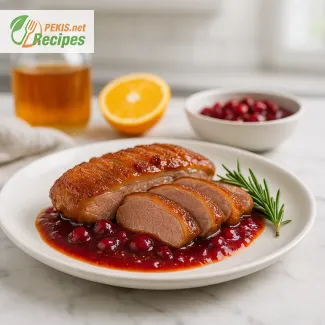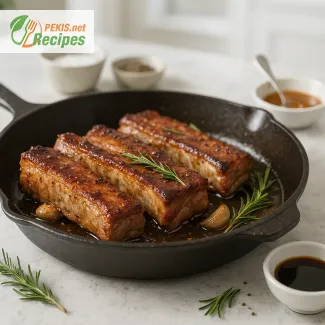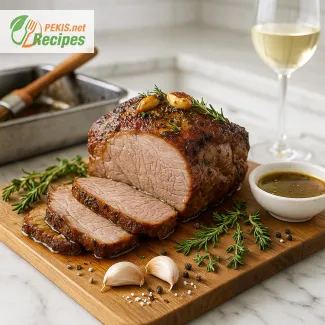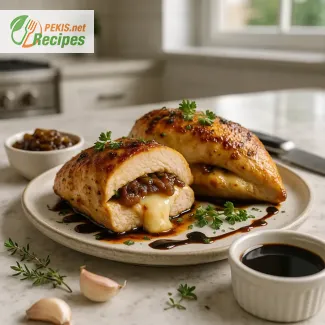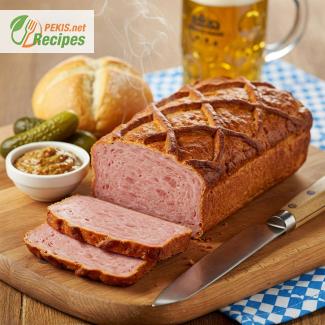
Discover the Rich Bavarian Tradition of Leberkäse
A warm, savory slice of Germany on your plate
Few dishes embody the heart and soul of Bavarian cuisine quite like Leberkäse, a richly flavored meatloaf that has been a staple in German households and street food stalls for generations. Known for its smooth, fine texture, golden-brown crust, and comforting, mildly spiced aroma, Leberkäse is a dish that offers simplicity, warmth, and history in every bite.
Often enjoyed hot in a crispy bread roll with a generous dab of sweet Bavarian mustard, or sliced and served as a hearty meal alongside potato salad or sauerkraut, Leberkäse has earned its place as a culinary icon in Southern Germany. The word Leberkäse literally translates to "liver cheese," although ironically, the traditional version contains neither liver nor cheese. Instead, it’s a blend of finely ground pork and beef, subtly seasoned and baked to perfection, resulting in a dish that’s crisp on the outside and delightfully juicy within.
Originally created in the 18th century by the court butchers of Bavaria, Leberkäse was designed to be affordable, filling, and easy to prepare in large quantities—perfect for feeding the hungry working class. Over time, it evolved into a beloved classic served in beer halls, at festivals, and in family kitchens, transcending its humble origins. It’s now a symbol of German comfort food, especially popular in regions like Munich and the greater Bavaria area, as well as in neighboring Austria and parts of Switzerland.
Making authentic German Leberkäse at home is a truly rewarding experience. The process—though simple in its ingredients—requires a few key techniques to replicate that smooth, bouncy texture and caramelized crust that defines a perfect loaf. It’s a recipe steeped in heritage, but also versatile enough to adapt to modern kitchens and tastes. With a few careful steps, anyone can bring this traditional delicacy into their home, recreating a piece of Bavarian culture with every bite.
This dish is not only about flavor—it’s about tradition. From the early morning aroma wafting from butcher shops in Munich to the satisfying crunch of a freshly baked roll filled with steaming slices of Leberkäse, this meatloaf has captured the hearts (and stomachs) of millions. Whether served warm or cold, thick-cut or thinly sliced, this is a meal that brings people together and tells a story of culinary heritage passed down through generations.
As you explore this authentic recipe, you’ll learn how to create that perfect emulsion of meat and spices, how to bake it just right for that crispy top layer, and how to serve it like a true Bavarian. Whether you’re looking to impress at Oktoberfest, add something hearty to your weekly menu, or simply reconnect with your German roots, this recipe is the perfect place to start.
The beauty of Leberkäse lies not only in its flavor and texture, but also in its cultural significance. It’s more than just a meatloaf—it’s a celebration of German tradition, a dish that evokes nostalgia and togetherness. Prepare to slice into something timeless and delicious.
Next, we’ll walk you step-by-step through the preparation of Leberkäse, from selecting the right cuts of meat to achieving that bakery-style golden crust. But first, let’s take a look at the ingredients that make this dish a true Bavarian masterpiece.
- Chill the meat and fat. Dice the pork shoulder, beef chuck, and back fat into small cubes. Place them in the freezer for about 30–40 minutes until partially frozen. This ensures a better texture when grinding and prevents the mixture from heating during processing.
- Prepare the spice mix. In a small bowl, combine salt, white pepper, marjoram, nutmeg, cardamom, coriander, and minced garlic. Set aside.
- Grind the meat. Using a meat grinder fitted with a fine plate, grind the chilled pork, beef, and fat separately. For a smoother texture, grind each type of meat twice.
- Blend with spices. Add the meat and spice mix to a food processor in batches. While blending, slowly add crushed ice to emulsify the mixture. The final consistency should be smooth and slightly sticky.
- Add sautéed onions. Finely dice the onion and lightly sauté it in a non-stick pan without browning. Let it cool, then blend into the meat mixture.
- Prepare the loaf pan. Lightly grease a loaf pan (30 cm / 12 inch) with oil. Spoon the meat mixture into the pan, pressing it down firmly to avoid air pockets. Smooth the top with wet hands or a spatula.
- Score and bake. Use a wet knife to score a cross or wavy pattern across the top surface. Preheat the oven to 160°C (320°F). Bake the Leberkäse for 90 minutes until the top is golden brown and the internal temperature reaches 70°C (160°F).
- Rest and serve. Allow the Leberkäse to rest in the pan for 10 minutes before slicing. Serve warm with mustard and fresh rolls, or cold with potato salad or pickles.
Elevating Your Leberkäse: Modern Twists on a Bavarian Classic
Creative tips and healthier variations to refine your homemade Leberkäse
While the traditional Leberkäse recipe has stood the test of time for centuries, modern home cooks and culinary enthusiasts often look for ways to improve and personalize the dish to suit evolving tastes, dietary preferences, and nutritional goals. With a few thoughtful adjustments, it's possible to create a Leberkäse that not only respects its Bavarian roots but also embraces contemporary food values. Whether you're aiming for a more complex flavor profile, a lighter version, or a healthier approach, this guide offers expert advice to transform a classic into something uniquely yours.
Flavor-boosting ingredients to enrich the taste
Leberkäse is defined by its mild yet comforting flavor, but that doesn’t mean it has to stay basic. By adding or substituting a few ingredients, you can introduce new dimensions of taste without compromising the texture or authenticity of the dish.
Smoked elements for depth
Adding a small portion of smoked bacon or smoked paprika to the mixture can bring a subtle smokiness that enhances the overall aroma. This creates a deeper, more layered profile that’s particularly satisfying when served warm.
Cheese for creamy richness
One popular variation is Käseleberkäse, which incorporates small cubes of semi-hard cheese like Emmental or Gouda into the meat mixture. These pockets of melted cheese not only enrich the flavor but add textural contrast with creamy bites in between the firmer meat.
Fresh herbs for brightness
Traditional Leberkäse uses dried marjoram, but incorporating fresh parsley, chives, or thyme can add freshness and color, particularly when serving the dish cold. These herbs also work well with mustard or pickles, making the overall dish feel more vibrant and refined.
Garlic and onion variations
Instead of just lightly sautéed onions, try caramelizing them for extra sweetness or using roasted garlic for a milder, nuttier flavor. These small tweaks can significantly influence the end result, giving your Leberkäse a unique signature.
Why homemade Leberkäse is superior
There are numerous reasons why making Leberkäse at home is preferable to store-bought versions:
- Control over ingredients: You can select high-quality cuts of meat, choose your preferred fat ratio, and avoid preservatives or fillers commonly used in mass-produced versions.
- Customization: Homemade allows you to adjust seasoning to your taste, add special ingredients, and even control sodium content.
- Texture and freshness: Freshly baked Leberkäse has a crisp crust and tender interior that’s rarely matched by pre-packaged alternatives.
Common mistakes to avoid when making Leberkäse
Even experienced cooks can run into issues when preparing Leberkäse. Being aware of the following common pitfalls can help ensure consistent success:
Overheating the mixture during blending
The meat and fat mixture must remain cold throughout the process to maintain a smooth emulsion. Overheating can cause fat separation, resulting in a grainy, oily texture.
Skipping the chilling step
Failing to chill the meat before grinding or blending can ruin the final consistency. Partial freezing of the meat and fat is essential for a tight, bouncy structure.
Underseasoning
Because Leberkäse is relatively mild by design, insufficient seasoning can make it taste bland. Always measure spices carefully and adjust based on meat quality and personal preference.
Incorrect baking temperature
Leberkäse should be baked slowly at a moderate temperature (around 160°C / 320°F) to ensure even cooking and develop that signature golden crust. Baking too fast or too hot may result in a dry or uneven loaf.
Healthier alternatives for a lighter version
Traditional Leberkäse is high in fat due to the inclusion of pork shoulder and back fat. However, with a few substitutions, you can enjoy a leaner yet still flavorful version.
Lean meat options
Swap pork shoulder with lean turkey or chicken thigh meat. These cuts maintain moisture without excessive fat and still grind well for emulsification.
Plant-based adaptations
For a vegetarian alternative, consider blending cooked lentils, mushrooms, and oats with umami-rich seasonings and baking it in a loaf pan. While not traditional Leberkäse, it can replicate the comforting texture and hearty feel of the original.
Reduce sodium
Store-bought versions can be heavy on salt. In your homemade version, gradually reduce salt content and balance with natural flavor enhancers like mustard, vinegar, or roasted spices to maintain taste.
How presentation and serving can enhance the dish
Sometimes improving a dish isn't just about what’s inside—it’s about how it’s presented and enjoyed. Serve Leberkäse with homemade sweet mustard, crispy pretzel rolls, or a warm potato and cucumber salad for a complete Bavarian experience. For visual appeal, top the loaf with fresh herbs or thinly sliced pickles before serving.
The value of heritage and experimentation
Leberkäse is a dish deeply connected to German culture and tradition, yet it remains open to modern interpretations and personal flair. By understanding the foundation and respecting the method, you can confidently experiment with new ingredients, improve nutrition, and refine presentation to match your culinary vision.
Whether you’re a nostalgic cook revisiting flavors of your childhood or an adventurous food lover exploring European classics, a refined and improved Leberkäse is more than a recipe—it’s a journey into the heart of comfort food with room for creativity.
Contains allergens and gluten:
- Allergens: None inherently, but contamination may occur with pre-ground spices.
- Gluten: This traditional recipe is gluten-free unless contaminated by commercial spice blends or baking pan coatings.
Substitution tips:
- For a gluten-free version, use certified gluten-free spices.
- For dairy allergies (if any variant includes cheese), avoid Leberkäse with added cheese ("Käseleberkäse").
- For pork-free diets, substitute pork shoulder and fat with turkey thigh and duck fat.
Vitamins and minerals (per portion):
- Vitamin B12: 2.3 µg – Supports red blood cell formation and nerve function.
- Iron: 2.1 mg – Essential for oxygen transport and energy production.
- Zinc: 3.5 mg – Boosts immune system and wound healing.
- Phosphorus: 185 mg – Vital for bone health and energy metabolism.
- Niacin (B3): 5.4 mg – Promotes healthy skin and digestion.
Antioxidants (per portion):
- Selenium: 24 µg – Neutralizes free radicals and supports thyroid function.
- Carnosine (from beef): ~400 mg – Protects cells from oxidative stress and improves muscle performance.
- Marjoram (flavonoids): ~15 mg – Provides anti-inflammatory and antimicrobial benefits.
